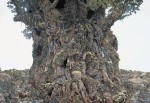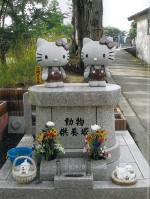Column Name
Title
The title of a current Japan Society exhibition, “Bye Bye Kitty!!!,” is rather off-putting; it is meant to be. The subtitle, “Between Heaven and Hell in Contemporary Japanese Art,” amplifies what it is about to some degree. This is an exhibit that is unfortunately all too timely.
Manabu Ikeda’s Existence (2004) depicts infinite expanses of ancient cities and cultures—plus flocks of birds, airplanes, and incongruous figures—crowded into nooks and crannies of a huge tree. The work is pen and acrylic ink on paper, mounted on board. It is from the collection of Joan and Michael Salke and appears courtesy of Mizuma Art Gallery and Diego Cortez Arte, Ltd.
(Photo by Photo by Manabu Ikeda)Yoshitomo Nara’s untitled C-print, which appears courtesy of Tomio Koyama Gallery, depicts two Hello Kitty figures atop a grave for pets.
(Photo by Photo by Yoshitomo Nara)Body
The exhibition was planned long before the devastating March earthquake and tsunami. But artists are often prescient, and it had become apparent for some time to younger artists that the era of kawaii (which means cute in Japanese) was over. Hello Kitty had exemplified the cartoonish charm and cult of youth exported by Japan. For years its smiley faces, childish penmanship, and soft, cuddly toys had pervaded international media. In the United States it attained an iconic level when a Hello Kitty balloon was added to the Macy’s Thanksgiving Day Parade, in 2007.
The 16 artists in the current show—mostly young, a few midcareer, eight of whom are women—have no patience forkawaii. They were born between 1959 and 1983, and for them, the image of Japan as childlike and exotic, a land of fantasy and escapism, was punctured along with the severe recession that started after the 1986-91 economic bubble.
These artists go beyond phenomenally popular manga and anime imagery and use their bitter knowledge and awareness of the failure of extreme materialism in their country to grapple with tough issues. While it is frightening to see how well these artists forecast the disasters that have recently befallen their country, a show like this fosters hope. Knowledge, coming to terms with reality, and intervention must be considered at least part of the solution to coping with disasters.
Small, but intense, the show features paintings, photos, videos, objects, and installations. It is beautifully installed in the Japan Society’s well-designed space. Curator David Elliott has divided it into three sections: Critical Nature, Threatened Nature, and Unquiet Dream, though he readily admits that these categories overlap. The first section deals with art that updates tradition and history; the second focuses on human disruption, pollution, and incursions into nature; and the third ventures into fantasy and nightmare worlds. In order to better understand these categories and the sense of the exhibit as a whole, I will turn to specific examples in each category.
In the Critical Nature section, Miwa Yanagi (born 1967) has staged a series of fictive “Grandmothers.” For this she asked a group of young women to imagine what they want to be like in 50 years. She then used makeup and digital manipulation to transform herself into old women, in personas ranging from entertainer and geisha to a chicly dressed old lady and a witch. All the resulting photographs are arresting and frightening. (And, as Elliott points out in the catalogue, not one of the young women envisions herself in a conventional setting of domestic happiness.)
In the Threatened Nature section, Manabu Ikeda, who was born in 1973, limits his technique to ink and acrylic paint applied on paper with a pen. He was primarily influenced by 18th- and 19th-century old masters, and one of his largest works is called Existence. In it, he has painstakingly reproduced a tree. Inspired by the huge fig trees strangling some of Cambodia’s temples in Angkor Wat, Ikeda’s tree contains infinite expanses of ancient cities and cultures crowded into nooks and crannies. These alternate with miniature flocks of birds, airplanes, and other incongruous, sometimes frightening figures. Ikeda here imagines a strange merging of ancient and modern dystopias.
In the same section, but in a totally different mood, hangs a very large, imposing, intricate nonobjective paper installation, titled Vortex, that artist Tomoko Shioyasu, who was born in 1981, made specifically for this exhibit. She has said that she bases her traditional paper-cutting technique on details in nature—cells, veins, water—essences of the roots of nature and life. The finished work is stunning and intricate; the shadows it casts are just as beautiful as the object itself.
In the third section, Unquiet Dream, we observe numerous discomfiting images, ranging from deformed Noh masks to paintings of babylike heads with helmets, to strange photos and videos. Hiraki Sawa, who was born in 1977 and lives and works in London, makes videos that emphasize displacement, inversions of size and scale, and impossible situations. His videos encompass subjects as diverse as animated rocking horses and cosmic views inspired by the sublimity of J. M. W. Turner’s landscapes. In his art, Sawa paradoxically manages to both soothe us and make us uncomfortable. He made the video Within, which appears toward the end of the show, specifically for it. The last work in the exhibit is a photo by Yoshitomo Nara, who was born in 1959 and is the oldest artist in the show. It perfectly illustrates the name of the exhibit: the untitled image is that of a grave for pets presided over by two Hello Kitty statues.
I have to agree with Elliott when he says at the end of his informative catalogue essay, “A new movement in art may soon begin or perhaps has already begun, as the works . . . in ‘Bye Bye Kitty!!!’ attest. I hope that something will emerge and grow from it, not in a parallel world, but in the real world.”
This is even more critical now in the face of the continuing disaster Japan and the world face. The show, which features work based on updated tradition as well as work that is totally new and original, is aesthetically beautiful, moving, and transformative. Many of the artists in it demonstrate staggering skill and craftsmanship. Every single work is gripping in often unexpected ways.
An additional reason to go to the exhibit is that in light of the current tragedy the Japan Society is donating 50 percent of the proceeds from all of its events (including this show) through June 30 to relief efforts. By seeing and learning about contemporary art by younger Japanese artists, you will also be helping to remediate a drastic situation.
“Bye Bye Kitty!!! Between Heaven and Hell in Contemporary Japanese Art” runs through June 12 at the Japan Society, 333 East 47 Street, between First and Second Avenues. For museum hours and more information, visit japansociety.org or call (212) 832-1155.






